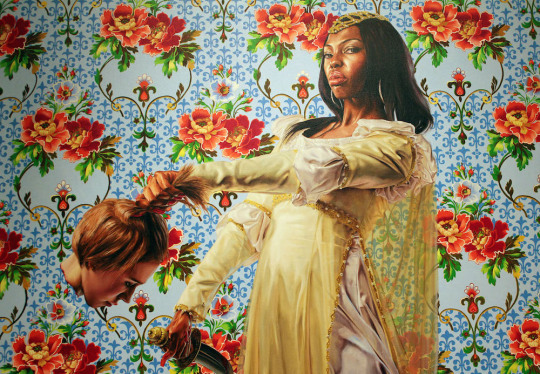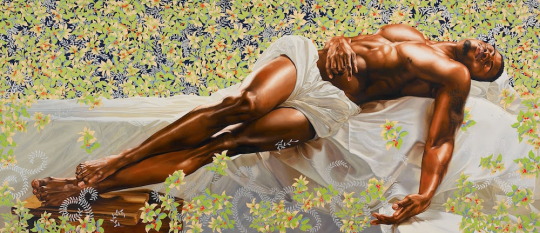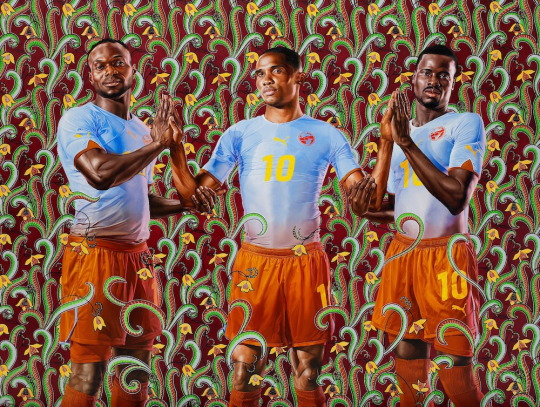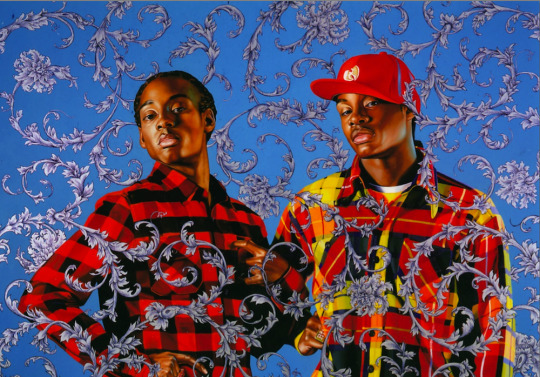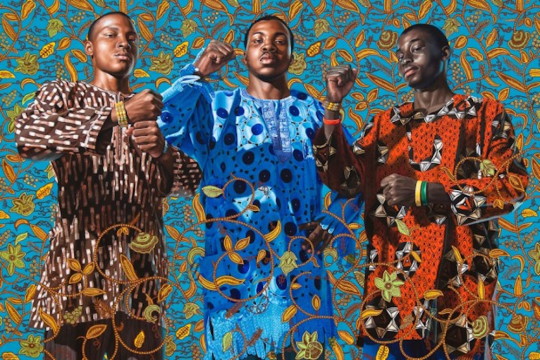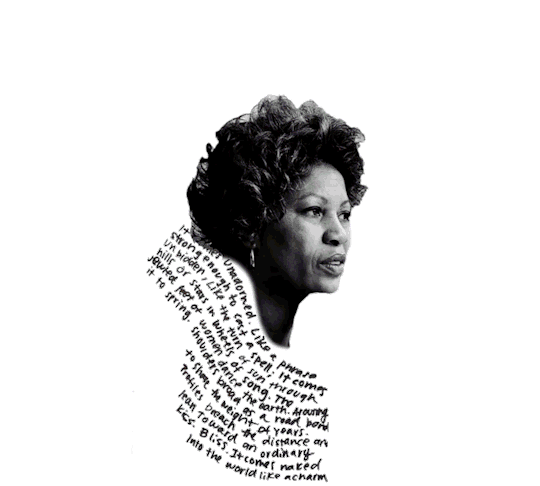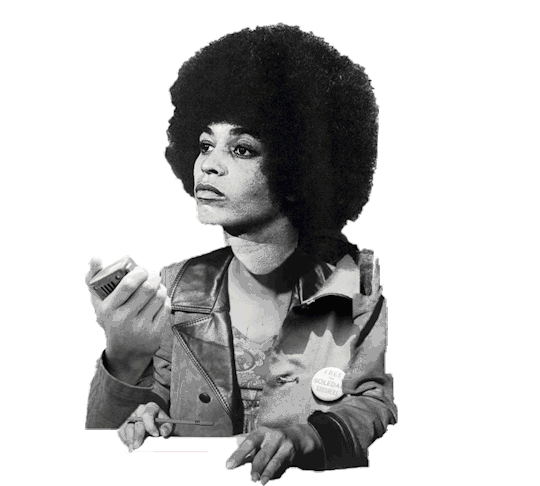Video
youtube
Stop motion collage explores female desire | Euphorbia by Jessica Wheele...
0 notes
Photo









Photos from Carrie Mae Weems’s “Kitchen Table Series” (1990)
32 notes
·
View notes
Photo




From Carrie Mae Weems’ Colored People, 1989-1990
17K notes
·
View notes
Photo

Mary, Comforter of the Afflicted II, Kehinde Wiley, 2016
Stained glass in aluminum frame 249 x 185 cm (98 x 72.8 in.)
494 notes
·
View notes
Photo

Mickalene Thomas (American, b. 1971), Naomi Looking Forward, 2013. Rhinestones, acrylic, oil and enamel on wood panel, in two parts, overall: 96 x 120 in.
259 notes
·
View notes
Photo


MICKALENE THOMAS “Angelitos Negros”, 2016 eight (8) two-channel HD video duration: 23 minutes, New York.
“Hunched over a computer in her studio, Thomas shows me one of the works that’s in the show. It’s a four-channel video piece based on Eartha Kitt’s performance of “Angelitos Negros,” or, “Little Black Angels,” a song that finds the singer wondering why, when she enters a church, she only sees images of white angels. She implores painters to paint black angels for “all good blacks in heaven.” Thomas’ take on the video features herself, Racquel, and an actress, all reenacting Eartha Kitt’s performance alongside Kitt’s original, their four voices intertwining for the audio.
“How come you don’t paint our skin?” Kitt, Thomas, and the other women ask in song. Even though the work positions Thomas as an observer of art, in reality she is one of the painters to whom the song begs representation. Her every work is an answer to the song’s plea—Mickalene Thomas is forever painting our skin.” —-The Creator’s Project, Gabrielle Bruney
2K notes
·
View notes
Text
Animation Artists/ Bibliography
Artists
Mickalene Thomas
Mickalene Thomas is a multimedia artist that transforms her photography and collages into large scale paintings. She is known for her use of rhinestones, wood paneling, bright colors and 70s patterns and motifs that makeup the elaborate fabrication of her subjects and the constructed interiors in which her subjects are placed. Her representation of black women brings a nuanced perspective to the understanding of the black feminie experience, by placing her subjects in provocative positions that demand the viewer's attention. As someone interested in the combination of the digital and analog, I have enjoyed studying her image making process that begins with shooting her models in a studio, collaging the photographs, and finally making large scale mixed media paintings from the work. Collage-making and mixed media practice has inspired my animations, such as the ‘It Comes Unadorned’ gof series that incorporates my painting and analog drawings with found images and text.
Jessica Wheeler (https://www.youtube.com/watch?v=v31TAQSUDYo )
Jessica Wheeler is a filmmaker based in Manchester and creates work with the intentions of finding new ways to look at the queer experience through the combination of collage and digital animation. I found her work Euphorbia, when looking for ways to animate collages. The piece uses cut collage and stop motion animation to create an internal exploration of sexuality. I am drawn to the way that she is able to make such a fluid, captivating scene that unravels before the viewer's eye. Her use of symbolic imagery as well is very powerful and something appreciate in artwork that has such an intimate an personal concept
Sonda Perry
Sondra Perry is an interdisciplinary artist who works with video and computer based media. The themes within her work include blackness, African American heritage, the representation of black people centering on the way blackness influences technology and image making. She is also very big on net neutrality and making sure there is equal access to the internet and especially her work. She implements this care by using open software to edit her work and makes her projects available online for free. The use of technology for her installations creates an interesting between human nature and the digital world. Often using her own personal experiences with race and melding with digital work such as 3d renderings, Perry is able to express racial inequalities through a medium that is often withheld and inaccessible from Black people. Her piece Black Girl As A Landscape is a single-channel video, where in a camera pans slowly across the silhouetted body of a horizontally framed figure as she approaches or distances herself from the lens. As the camera zooms in we see the details of her fabric and and the eyes begin the piece through as the whites of the eyes contrast against the dark silhouette.
I am inspired by the experimentalism in film, the use of technology based methods to discuss the black experience and chronicle it from a woman's perspective.
Carrie Mae Weems
Carrie Mae Weems legacy as a contemporary artist working with photography, installation video, and print work. I have drawn inspiration from her Kitchen Table Series, a series that deeply resonates with me. Weems' series of self portraits sitting at her kitchen table while different life scenarios take place around her, featuring family members, lovers, friends and the most poignant ones only featuring herself, explores the representation black relationships and self, that I am working towards developing my work themes.
Kehinde Wiley
Kehide Wiley is an American portrait artist known for his naturalistic paintings of Africam Americans painted in the style of Old Master portraits. I have examined his work in my Fabrication as Race class and focused on how his representation of black people in a notable european art style draws to the forefront examinations of black representation and self perception. Similar to the way that Mickalene Thomas paints her subjects in positions of reclined nude women popular in european history. I have seen a few of his paintings in real life including Philip the Fair, 2006 in The Mint Museum in Charlotte, North Carolina and his 2018 portrait of President Obama in the National Portrait Gallery. His use of bold colors and patterned backgrounds draws the viewer's attention and is a way that he is able to extend the subject's identity through a decorative design.
Articles
Mickalene Thomas: Afro-Kitsch and the Queering of Blackness I have been studying multimedia artist Mickalene Thomas’s large collage acrylic paintings and her representation of assured black women from a feminist lense. This essay written by visual culture theorist, Derek Conrad Murray deconstructs the ways that Thomas’s identity as queer black woman, informs the ways that she portrays her female subjects and complicates the understanding of the black experience as it is perceived through the post-black art movement. The essay positions Thomas’s work within the greater post-black contemporary art movement, a movement that “articulates the frustrations of young African American artists (the post–civil rights generation) around notions of identity and belonging they perceive to be stifling, reductive, and exclusionary” (Murray). The essay analyzes a few of Thomas’s pieces and evaluates its effectiveness in reimagining black female subjectivity.
The Vasulka Effect ( https://sagafilm.is/film/the-vasulka-effect/ )
Watching the Vasulka Effect, I was intrigued by the couple's approach to video making and their role in creating a movement for new media art in the 1970s. As an individual interested in the music and art culture of the 70s, I was entertained by the name dropping of the artists that the Vasulka’s worked with. From Miles Davis, the Rolling Stones, and Jimi Hendrix, I admired the documentary work that went with bringing a new visual element to understanding music during this time. Their involvement with the drag community was also fascinating as I was able to see the connection made between experimental art making and underground communities. I think this also speaks to the use of the video medium as an effective tool to tell and showcase marginalized stories in an artistic manner. The way that Steina and Woody work with their video projects emphasizes the importance of collaboration. Their works are experiments, testing how to make sound information into a moving image. They attempt to make something that can not be seen visible, calling attention to how limited our senses are. One thing I loved about their process that Steina mentioned was how the two artists seemed to always “be playing around” and trying new alternatives to working with technology..
Petra Meyer and Katrin Kaschadt, “William Kentridge, Overvloed”
South African artist, William Kentridge's work features short animations made from large scale drawings using mainly back charcoal complimented by color pastel chalks. He is known for his technique that involves erasing, and changing parts of the drawn image and reworking the same frame. Leaving in the erasure marks visible through the process making the transformation of the image an integral part of the animation as a whole. “The animation comes into being therefore, by addition and subtraction, creation, and destruction” (Meyer, Kaschadt). Through this process, the markings and leftover tracings of the image become part of the animation and contribute to the artist's celebration of the imperfect relationship people have with change. His work was a rejection of the modernist aesthetics that placed importance on clean and “pure” work. His process and attention to the shadows reminds me of something that happens in printmaking called "ghost shadows”. These are images that are left behind on a plate or printing material and leave a light image behind on the new print. While there are ways to get rid of these and make sure they do not appear, some decide to keep them as part of their new print. I think the intentional use of these shadows and past images in work is very interesting and brings more texture and depth into the work when the marks left behind become as important as the blackest mark on the page. His work illustrates the relationship between South Africa's socio-political condition and history and the relationship between the individual and their landscape. .
0 notes
Photo

Krzysztof Wodiczko, Guests, 2009, (5) synchronized video projectors with sound system, Polish pavilion, 53rd Venice Biennale, Venice.
509 notes
·
View notes
Text
William Kentridge
Two weeks ago we read about William Kentridge, South African artists known for his prints, drawings and animated films. Focusing more on his animated work, his practice explores how "perception and experience are transformed into knowledge; the nature of emotions and memory; the relationships between desire, ethics, and responsibility" (Christov-Bakargriev).
I think the term transformative is the most evocative of Kentridge's work as his animations are made by making drawings that he makes sets of erasures and additions to every frame. Through this process, the markings and leftover tracings of the image become part of the animation and contribute to the artists celebration if the imperfect relationship people have with change. His work was a rejection of the modernist aesthetics that placed importance on clean and "pure" work, "in celebrating the leftover, the shadow, the trace, the discarded, the unproductive, the doubt, the unresolved, the uncertain, the "dirty" smudge rather than the [...] pristine, high -tech digital effects[...]" (Christov-Bakargriev). His process and attention to the shadows reminds me of something that happens in printmaking called "ghost shadows". These are images that are left behind on a plate or printing material and leave a light image behind on the new print. While there are ways to get rid of these and make sure they do not appear, some decide to keep them as part of their new print. I think the intentional use of these shadows and past images in work is very interesting and brings more texture and depth into the work when the marks left behind become as important as the blackest mark on the page.
1 note
·
View note
Photo


Teeth linocut stamps used as inspiration for flip book animation
1 note
·
View note
